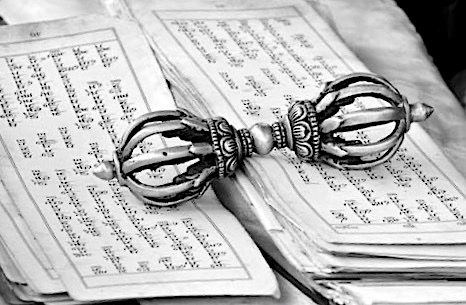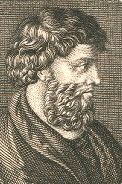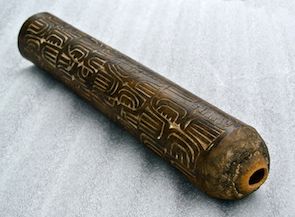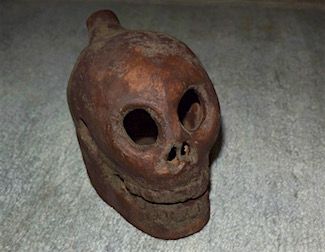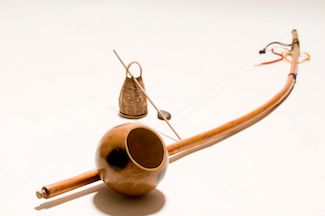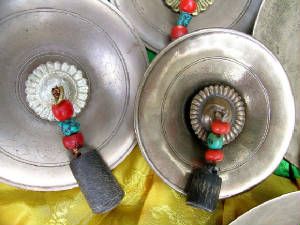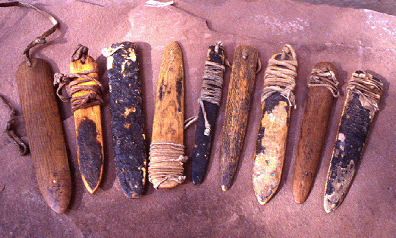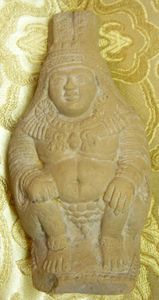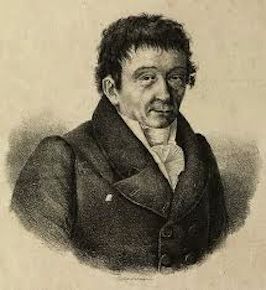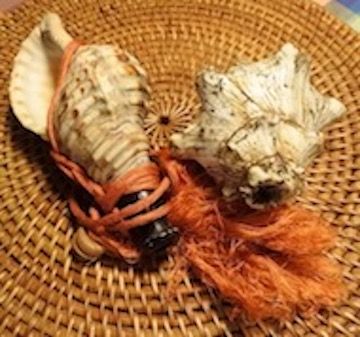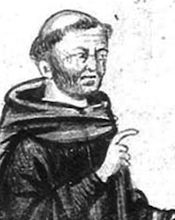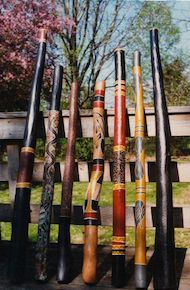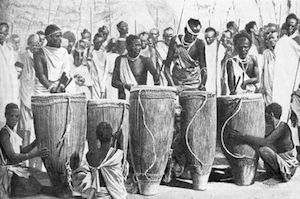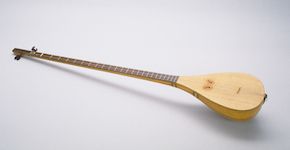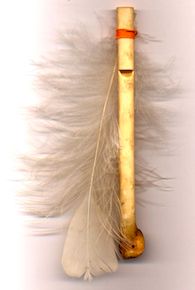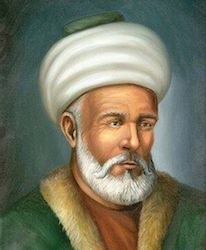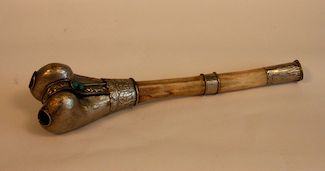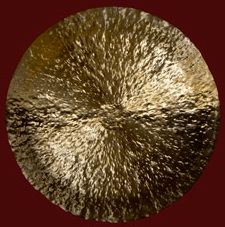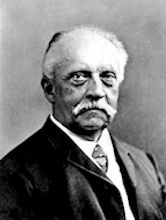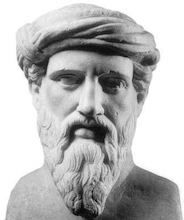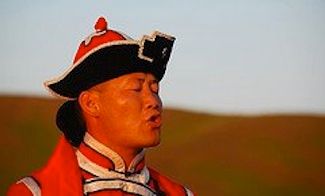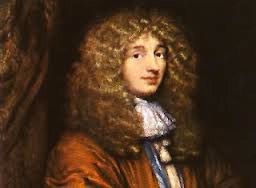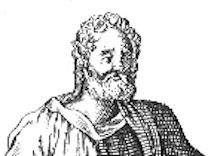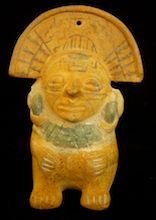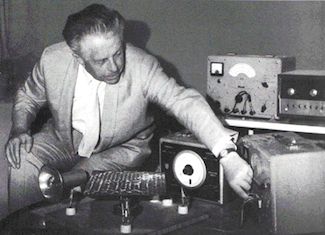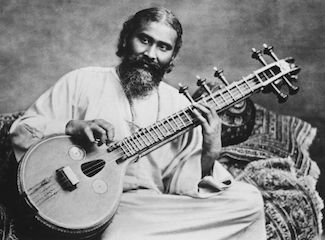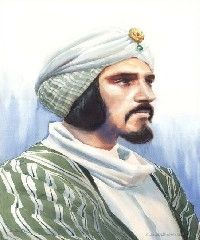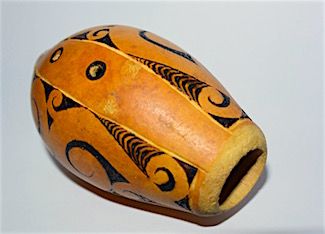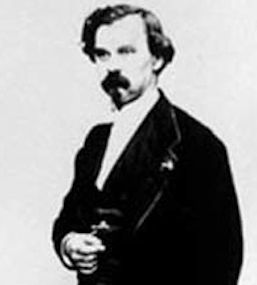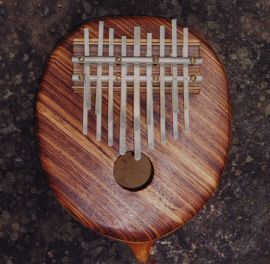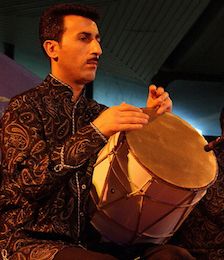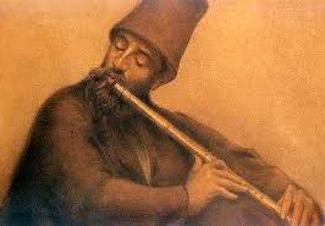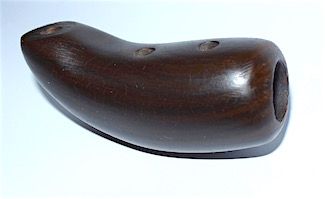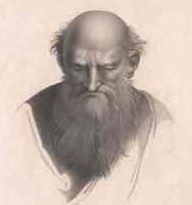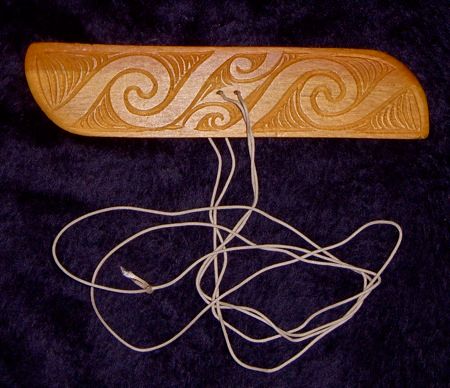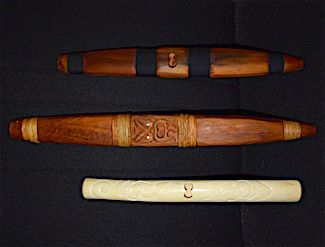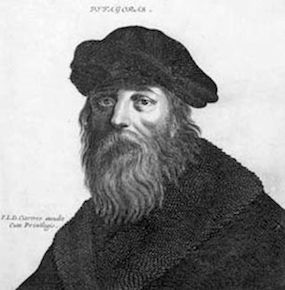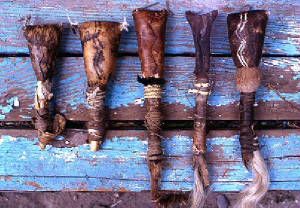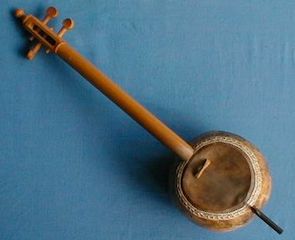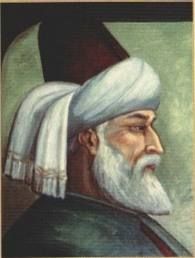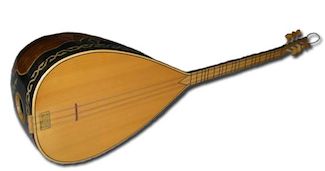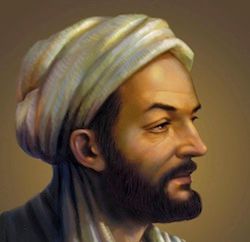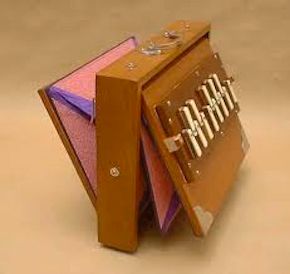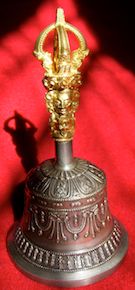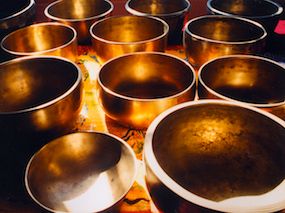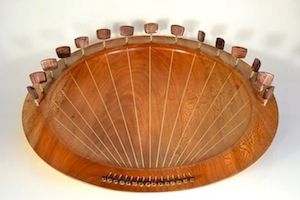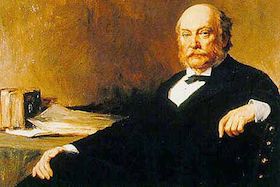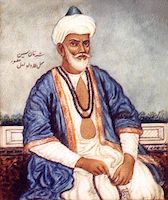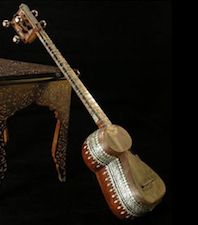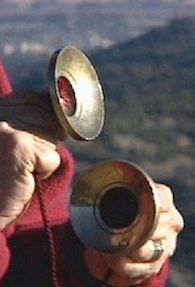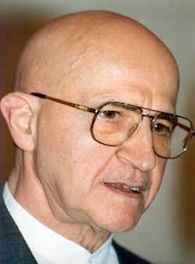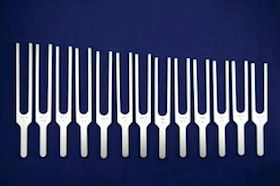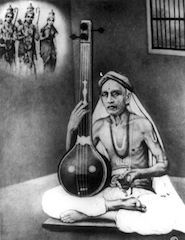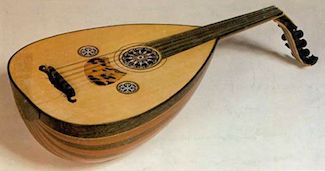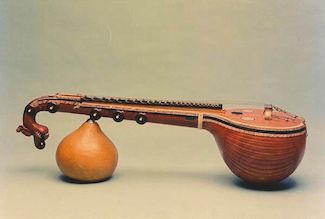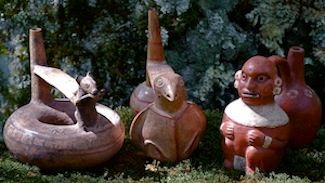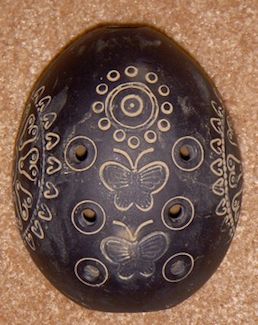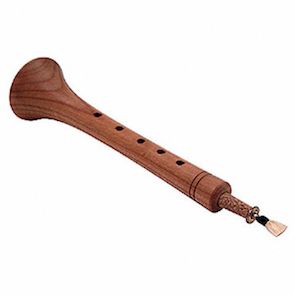Sound Glossary
Instruments, Philosophers, Traditions
Aristoxenus
370 - 304BC
Aristoxenus, an Aristotelian philosopher, argued that musical intervals should be classified by their effects on listeners as opposed to merely examining their mathematical ratios which was contrary to the Pythagorean. This notion by Aristoxenus, brought the scientific study of music into the mind, followed by the first psychophysics experiments at the dawn of experimental psychology, which mapped changes in the physical world onto changes in the psychological world.
Aristoxenus, known in antiquity as 'o mousikos' ( the Musician), was born in Calabria, at Tarentum, Italy. A Greek Peripatetic philosopher, and a pupil of Aristotle. Most of his writings, which dealt with philosophy, ethics and music, have been lost, but one musical treatise, Elements of Harmony, survives incomplete, as well as some fragments concerning rhythm and meter.
Aristoxenus sought to separate the study of music from that of both physics and mathematics. He refused to make use of any ratios in his treatise, distinctly contra the Pythagoreans, and he also spoke of the raising and lowering of pitch in terms of tension and relaxation, which in his day would admit of no exact numerical measurement, rather than in terms of string-length, from which ratios could be calculated.
moreAsmat Fue
Ceremonial wind instrument of the last indigenous tribe of New Guinea ( Irian Jaya ). The Asmat ( tree people ) tribal culture occupies the southwest coastline now known as West Papua, Indonesia. A type of bugle or trumpet made of bamboo and carved on the exterior by using the tooth of a rat (shell can also be used ). Used as a signaling device during headhunting raids to instill fear or to paralyze the enemy. Used during 'feast cycles' and played in the 'lead' canoe, and blown to signal the return to the village. The fue is wrapped in a pandanus leaf and stored above the central hearth ( boiyir ) in the Bachelor's House or the family home which is a stick and leaf structure raised on stilts. According to Asmat legend, the Arch-Woodcarver Miroko-atayao was the only survivor after all the people in the world had been devoured by a gigantic crocodile. As he hunted and fished he 'found' the most important animals and 'created' a series of 6 ceremonial houses by drawing them in the sand. He also encountered the gigantic crocodile (eu ), which made a strange roaring noise. This is the sound of the Fue. When a woodcarver carves the Fue, it is said that he gives the wood life. The bamboo signal horns were often used as pillows, in case of danger they were within reach to be sounded instantly.
moreAztec Death Whistle
In Aztec mythology, Ehecatl ("wind") was the god of wind, an aspect of Quetzalcoatl. His breath moved the sun and pushed away rain. Theories are, that the Aztecs played this mournful wail from the so-called "Whistles of Death" or "the Roar of Death" before they were sacrificed to the gods. Or, Nobility was escorted into the death state by Ehecatl, summoned by thousands of their subjects blowing the Death Whistle. Or, meant to help the deceased journey into the underworld, while tribes are said to have emitted terrifying sounds to fend off enemies. Experts also believe pre-Columbian tribes used some of the instruments to send the human brain into a dream state and treat certain illnesses. The ancient whistles called Ehekachiktli, could guide research into how rhythmic sounds alter heart rates and states of consciousness. This is part of a growing field of study that includes archaeologists, musicians and historians. Medical doctors are interested too, believing the Aztecs may have used sound to treat illnesses.
➨ Click HERE for Video on the Whistles of Death
moreBerimbau
A descendent of the musical bow or 'mbela' of central Africa. Known to the Mandinka of the Angola area as 'Kabuni', and used by medicine men and women in their healing rituals. Used as an accompaniment of storytellers and singers. It was also used by the Bantu and Yorubas of Mozambique and Nigeria, and by the Zulu who call it 'Ugubhu'. The instrument has been played in Africa since prehistoric times, and was taken to Brazil by African slaves, and is now widely used as the traditional instrument of Capoeira; which is a martial art, dance, and spiritual discipline. The name Capoeira is a Brazilian Indian word given to a small partridge whose male is very jealous and engages in fierce fights with its rivals.
In Cuba, where the berimbau is called 'Borumbumba', 'Sambi', 'Pandiguaro', or 'Gorokikano', it is used in Afro-Cuban ceremonies to talk to the souls of the dead.
On the island of Guam it is called 'Mbilimbau'.
A wire is tied to one end of a wooden pole, and the pole is flexed, and the wire secured to the other end. A gourd resonator is attached using a piece of thin rope that goes through the gourd, and the gourd is slid onto the taunt bow. It is played with a wooden stick which holds a basket shaker in the palm, and holds a small stone clasped between the index finger and the thumb. The stone changes the pitch by being pressed into the wire bowstring. Pitch is also controlled by moving the resonator gourd in and out from the body.
moreBonpo Shang
The ritual upturned flat hand bell of the Bonpo, spirit mediums, and Himalayan shamans. Made from a consecrated metal alloy, and used to 'throw' or 'cast' thoughts. Symbolically similar to the dril-bhu used by Tantrist Buddhists.Used in conjunction with a phurba in rites involving dkyil-khors and Thread Crosses. The Shang consists of 3 main pieces: the flat bell, the center piece that holds the knocker which is called a 'Gakyil' ( Wheel of Joy ), and the striker or knocker which is made from animal horn. The origin of the Shang begins with the ancient Kingdom of ZhangZhung nearly 18,000 years ago. Sizes range from approx. 3" to 20" in diameter. Used by Asian shamans in healing rituals and used in ceremonies today by practitioners of Yungdrung Bon.
➤ Learn More About Advanced Training on this Instrument
moreBullroarer
Known as the 'voice of God' to the Australian Aborigines and given to the males of the Clan at naming ceremonies or other auspicious occasions. Used as a 'talk back switch' to the Creator. To sound a Bullroarer it is swung lasso style which causes it to spin and make a 'humming type' sound. It is called by several different names including 'Burliwarni','Ngurrarngay',and 'Muypak'. They were used to display sacred symbols and sounded to warn the uninitiated that they were being shown. They were also used to send animals into ambush, and to alert one tribe of anothers presence, and in rainmaking ceremonies. Their bullroarers or sacred tunduns, are of two types, the grandfather or man tundun, distinguished by its deep tone, and the woman tundun with a weaker shriller note.
This type of instrument has been used all over the world. To the Maori it is called 'Purerehua'(butterfly), and it was used by North American Native Cultures from the Athabaskan, Nootka, Yokuts, Pomo, Hopi, Aztec and more. The Navajo call it the 'groaning stick' (tsin di'ni) and use it to drive away evil or drive out illness. Made from pine wood that has been struck by lightning, covered with yucca pitch, and attached to a cord made from bighorn or buckskin. During Navajo sacred ceremonies, the medicine man uses the bullroarer to slice through the air, creating an opening that allows the Yei B'Chei (diety) to enter the physical world. At certain Moqui ceremonies the procession of dancers was led by a priest who whirled the bullroarer. In New Guinea it was placed inside humanlike effigies in the throat area symbolizing the spirit voice of the effigy and was sometimes used in ceremony. Among the Egba tribe of the Yoruba race the supposed Voice of Oro, their god of vengeance, is produced by the bullroarer, which is actually worshipped as the god himself. Used as a fishing charm in the Torres Straits, and in Sri Lanka in Buddhist festivals. Sometimes, as among the Minangkabos of Sumatra, it is made of the frontal bone of a man renowned for his bravery.
moreCharm Rattle
Wealth rattle from the Bactrian Empire Period of ancient India. The terra cotta rattle is an effigy of Kubera, the wealth and prosperity god. The hollow interior had magical charms placed inside, and when shaken, summoned Kubera. Some sources say that priests shook the rattle over patrons to bestow wealth upon them during festivals. The rattle pictured, was found near Chandraketugarh.
moreErnst Florens Friedrich Chladni
1756 - 1827AD
Is there a connection between sound, vibration and physical reality? Many inquisitive people have searched for a way to demonstrate this premise. Even before the introduction of quantum physics individuals have sought to make waves in "seemingly solid" material visible.
In 1787, the German musician and physicist Ernst Chladni published - 'Discovery of the Theory of Pitch', making it one of the first treatises on the science of sound. In this and other works, he laid the foundation for that discipline within physics that came to be called acoustics. He is sometimes referred to as the "father of acoustics".
Chladni observed that when a metal plate covered with sand or other similar substance was made to vibrate by running a violin bow across it perpendicularly, a pattern emerged in the sand. Through careful documentation he theorized that sound affects physical matter and that these changes can be repeated. He produced diagrams of his experiments which came to be called, "Chladni figures." He went on the lecture circuit in Europe and demonstrated his finding to live audiences, which included a command performance for Napoleon. Chladni so delighted Napoleon he offered him 6000 francs for his performance. Napoleon then offered 3000 francs to anyone who could explain this phenomenon. This prize was awarded to Sophie Germain in 1816.
moreConch Shell
An offering vessel used by many cultures on all the world's continents.
One of the 5 weapons of Vishnu to destroy evil forces and known to the Hindu's as the 'shankh'. According to Hindu mythology it was the primordial sound of creation.
The Tantric object associated with the 'spirit of air',proclaims the glory of the Saints in Buddhism. The white conch which coils to the right symbolizes the deep, far reaching and melodious sound of the Dharma teaching, which being appropriate to different natures, and aspirations of the disciple, awakens them from the deep slumber of ignorance and urges them to accomplish their own and other's welfare. Played in pairs producing single held notes with rising attack. Known as 'Dung-dkar' in Tantric Buddhism.
The conch is a Bon auspicious instrument representing the 'consummation of the means leading to Enlightenment.'
Used throughout the Pacific rim cultures as a signaling and ceremonial wind instrument. Known as 'Putatara' to the Maori.
Used by the Aztec culture in ceremonies to signal the 4 directions, and used to call the rain god 'Tlaloc'. It is said that Quetzalcoatl created life with the aid of a conch shell and he is always pictured wearing a conch pectoral. The Aztec name is Quiquiztli, and the person who plays it a quiquizoani. This is the instrument that Quetzalcoatl played to defeat the devious challenge of Mictlantecuhtli, the Lord of the Dead, and reclaim the ancestral bones of humanity at the start of the Fifth Sun.
moreConstantine the African
1020 - 1087AD
A Tunisian doctor of the eleventh century. The first part of his life was spent in Tunisia and the rest in Italy. In Salerno, Italy, he became a professor of medicine and his work attracted widespread attention. A few years later Constantine became a Benedictine monk, living the last two decades of his life in the Monte Cassino monastery.
It was in Italy where Constantine compiled his vast opus, mostly composed of translations from Arabic sources. He translated into Latin books of the great masters of Arabic medicine: Razes Ali Ibn Massaouia Baghdad, Ibn Imran, Ibn Suleiman, and Ibn Al-Jazzar. These translations are housed today in libraries in Italy, Germany, France, Belgium, and England. They were used as textbooks from the Middle Ages to the seventeenth century.
It was through these translations, that the music therapy of the Arab world was introduced to Europe, most importantly his translation of the 'Viaticum', where he introduces the Arab concepts of the use of music in Astrology, Philosophy, and Medicine.
moreDidgeridoo
Known in the Northern Territories of Australia as YIDAKI, and most likely the oldest musical instrument in the world. Cave paintings in Australia show didgeridoos being played in pictographs that date to 40,000BC. Made from the hollow log of the eucalyptus, bloodwood, or ironwood tree that has been hollowed out by white termites, and used as the primary ritual wind instrument of the Aborigines. Used in ceremonies to 'pull' the listener into the Dreamtime. Excellent entrainment tool.
moreDrums
One of the most widely dispersed instruments on the planet. Practically every culture has used the drum in ceremony, ritual, and shamanic healing; not to mention all the music avenues from classical orchestras, to jazz, rock, and more. Generally made of wood and animal skin, we find body examples made from human skulls, turtle shells, clay, and metal; to skins from sharks, elephant, goat, elk, snake, and more. Shells can be wide and deep, to hoops and shallow frames. Drumming is used to bring communities together, signal through dense jungle, initiate trance, journeying, and even marching into battle.
moreDutar
A two stringed instrument played with arpegios. It originated among the Kazakh and Kyrgyz and was the special instrument of the Baksi Shamans. Also known as a Dombra. The Dutar is employed in a sacred dance known to the Altai shamans, which spread through central Asia, and was adopted by some Sufi orders. This dance has good results on autism in geriatrics, oncology, immunology, neurology, cardiology. It is effective against depression and anxiety.
moreEagle Bone Whistle
These whistles are considered very sacred and to blow them for any other purpose would not be respectful.
Used by the shamans of Asia and the Native Peoples of North America. Used by Medicine Men to call spirits, blown in time with the drum by the dancers during the Sun Dance, and used during the Grass Dance.
The tibula bone of an eagle wing is used for the whistle. It is attached to a buckskin cord and tipped with a white plume feather from the breast of a golden eagle. The sound of the eagle bone whistle can be heard by the Great Spirit (Wakan Takan).
moreEuclid
325 - 265BC
Euclid of Alexandria, was a Greek mathematician, often referred to as the "Father of Geometry". He was active in Alexandria during the reign of Ptolemy I (323–283 BC). His Elements is one of the most influential works in the history of mathematics, serving as the main textbook for teaching mathematics (especially geometry) from the time of its publication until the late 19th or early 20th century. In the Elements, Euclid deduced the principles of what is now called Euclidean geometry from a small set of axioms.
Euclid's algorithm is a way of finding the highest common factor of two numbers. The algorithm is called Euclidean because it appears in Euclid's Elements as proposition 1 of book 7. It can be useful in all sorts of situations. But what has it got to do with music?
Right from the time of Euclid, and even before, there has been a mathematical way of talking about music. Musicians talk about pitch, that is how high or low a note is. You can visualise this as how high or low it appears on a stave, or how far to the right or left it would be on a piano. Today scientists use a sound's frequency to describe its pitch in mathematical terms: for example the middle A on a piano usually has a frequency of 440 cycles per second. This simply tells us how many individual sound waves there are each second in that sound.
moreAbū Naṣr Muḥammad ibn Muḥammad Fārābī
872 - 950AD
Abu Nasr Muhammad ibn Muhammad ibn Tarkhan ibn Awzalagh al-Farabi may rightly be acclaimed as one of the greatest of Islamic philosophers of all time. Al-Farabi was known to the Arabs as the 'Second Master' (after Aristotle), and was 'the founder of Arab Neo-Platonism and the first major figure in the history of that philosophical movement since Proclus'. Farabi also participated in writing books on early Muslim sociology and a notable book on music titled 'Kitab al-Musiqa' (The Book of Music) which is in reality a study of the theory of Persian music of his day, although in the West it has been introduced as a book on Arab music. He invented several musical instruments, besides contributing to the knowledge of musical notes. It has been reported that he could play his instrument so well as to make people laugh or weep at will. Al-Farabi’s treatise 'Meanings of the Intellect' dealt with music therapy, where he discussed the therapeutic effects of music on the soul.
Although many of his books have been lost, 117 are known, out of which 17 are on music. Hermann Von Helmholtz remarked that Farabi's musical scale may have been the most perfect scale of music ever devised, and Roger Bacon remarked that Farabi may have been the most influential philosopher to emerge from the Arab world. Today many traditional doctors from Istanbul, through Azerbaijan, to Mongolia, still use Farabi's books on music therapy as part of their traditional treatments, and a University in Kazakhstan is named after him.
moreFemur Trumpet
Made of the human thigh bone, the 'spirit evoking' trumpet known as the Kangling. A ritual object of Tantric Buddhism, and used at the time of tantric ceremony. Used in the Chod ritual 'Cutting off of Ego', and various dubthab rites. The Chod ritual appears to have its source during the shamanistic Bon period of Tibet, in the animistic cults relating to sacrifice and exorcism.
Played with the LEFT hand, and sounded in conjunction with the double-sided hourglass shaped drum made from a pair of human crania the Damaru. Because of their special qualities, they tend to be used in rituals concerned with wrathful deities or in contexts requiring special musical expedients. Used to drive away evil spirits, and used by 'naldjorpas'(adepts of the Short Path), to 'summon' spirits.
Used in conjunction with a Phurba (ritual dagger) for weather control in the summoning and cessation of rain.
moreGongs
Gongs are percussion instruments of either definite or indefinite pitch, in the form of a metal plate usually made of brass or bronze, and are of two types; hanging (vertical), or resting (horizontal). They are either flat with a clear sound, convex with a supple wall, or convex with a nipple or knob with a strong wall and definite pitch. They may be described as being a wind, chau, tam-tam, nipple, cup, bowl, plate, rin, orchestral, symphonic, whirling, ascending, or descending type of gong. The major gong centers of the world are China, Burma, Java, Indonesia, and Turkey. Communities of gongmakers exist in Sumatra, Thailand, Korea, Japan, Vietnam, Nepal, and India. Gongmaking was known to the ancient Egyptians, Greeks, Romans, Persians, Mongols, and Uighers. The gong is mentioned in writings during the 6th century in the time of the Emperor Hsuan Wu, originating in the country of His Yu in the western area in what was the Jang Kingdom between Tibet and Burma. In 496AD there is a mention in Chinese writings that a Gong came to the Imperial Palace from East Turkmenistan via the Silk Road. Evidence suggests that gongmaking was known as early as 3000BC and ancient alchemy sources put the gong as far out as 16000BC.
moreHermann von Helmholtz
1821 – 1894
Hermann Ludwig Ferdinand von Helmholtz participated in two of the most significant developments in physics and in the philosophy of science in the 19th century: the proof that Euclidean geometry does not describe the only possible visualizable and physical space, and the shift from physics based on actions between particles at a distance to the field theory. Helmholtz achieved a staggering number of scientific results, including the formulation of energy conservation, the vortex equations for fluid dynamics, the notion of free energy in thermodynamics, and the invention of the ophthalmoscope. His constant interest in the epistemology of science guarantees his enduring significance for philosophy.
Equally distinguished were his labors in physiological acoustics. He explained accurately the mechanism of the bones of the ear, and he discussed the physiological action of the cochlea on the principles of sympathetic vibration. Perhaps his greatest contribution, however, was his attempt to account for our perception of quality of tone. He showed, both by analysis and by synthesis, that quality depends on the order, number and intensity of the overtones or harmonics that may, and usually do, enter into the structure of a musical tone. He also developed the theory of differential and of summational tones. His work on Sensations of Tone (1862) may well be termed the principia of physiological acoustics. He may also be said to be the founder of the fixed-pitch theory of vowel tones, according to which it is asserted that the pitch of a vowel depends on the resonance of the mouth, according to the form of the cavity while singing it, and this independently of the pitch of the note on which the vowel is sung.
moreHermes Trismegistus
Master of all arts and sciences, perfect in all crafts, Ruler of the Three Worlds, Scribe of the Gods, and Keeper of the Books of Life, Hermes Mercurius Trismegistus-the Three Times Great, the 'First Intelligencer' was regarded by the ancient Egyptians as the embodiment of the Universal Mind.
All the fundamental and basic teachings embedded in the esoteric teachings of every race may be traced back to Hermes. He was the father of Occult Wisdom, the founder of Astrology, the discoverer of Alchemy. He was an Egyptian priest, the wisest of them all, supreme as philosopher for his vast knowledge, as priest for his holiness of life and practice of the divine cults, and worthy of kingly dignity as administrator of the laws. He founded the city of Hermopolis and was the messenger of the Gods called Thoth. He authored the Hermetic Books containing 36,525 volumes which contained the entire Egyptian philosopy, 4 books on Astrology, 10 books called the Hieratic on Law, 10 books on sacred rites and observances, 2 on music; and the rest on writing, cosmography, geography, mathematics and measures, and training of priests. Six remaining books concerned medicine and the body discussing diseases, instruments, the eyes, and women.
moreHippasus
530BC-450BC
Hippasus of Mentapontus, was a Pythagorean philosopher, one of Pythagoras’ first students initiated into Pythagoreanism and founder of the Mathematical Department of Pythagoras’ School.
He was active during the first 30 years of the 6th century BC and is considered as one of the oldest Pythagorean philosophers, as well as Pythagoras’ first assistant. While himself Pythagorean, Hippasus’ teachings differed slightly from those of Pythagoreans. For instance, he believed that the beginning of the world is matter (fire) rather than immaterial (numbers). He wrote a book Secret Logos, which he published under the name of Pythagoras, containing his philosophy. Only fragments of his book survive today.
He developed a theory of the musical scale and a theory of proportions, and showed how to inscribe a regular dodecahedron in a sphere.
A scholium on Plato's Phaedo notes him as an early experimenter in music theory, claiming that he made use of bronze disks to discover the fundamental musical ratios, 4:3, 3:2, and 2:1
moreRobert Hooke
1635 - 1702AD
Robert Hooke was perhaps the single most influential and experimental scientist of the 17th century. His interests ranged from physics and astronomy, to biology, chemistry, geology, architecture, and navel technology. He collaborated and corresponded with chemist Robert Boyle, and scientists Isaac Newton and Christian Huygens among others at that time. He is probably one of the most neglected natural philosophers of all time. The inventor of the iris diaphram in cameras, the universal joint used in automobiles, the balance wheel in a watch, the originator of the word 'cell ' in biology. Hooke is best known to those who study elementary Physics through Hooke's Law: 'The extension of a spring is proportional to the weight hanging from it.' Most people have never heard of Robert Hooke. From the publication of his 'Micrographia' (the first illustrated book on micorscopy), to his work on clocks, springs, gases, his inventions, and idea's on fossils, weather, gravity, and light. Robert Hooke has helped to shape our world today.
On July 8th, 1860 Hooke formed the experiment of glass vibrating in 6.4.8 places. This was done by putting flour on a glass plate, and bowing the edge of glass. The experiment states that Hooke oberved that the motion of the glass vibrated perpendicular to the surface of the glass, and that the circular figure of the flour changed into an oval one way, and the reciprocation of it changed it into an oval the other way. This phenomenon was rediscovered by Ernst Chladni in the 18th century. Its importance is that it influenced Faraday in thinking about lines of force in magnetic and electrical experiments. Hooke was quite acquainted with the properties of sound and had already experimented with sound amplication through the use of shape and structure. He understood that sound was made up of beats of air and had invented an ear trumpet to assist hearing. He knew also that sound could travel along a wire mechanically.
moreHuman Voice
The most accessible of instruments, the 'voice' is one of the easiest instruments through which 'intention' can be directed and focused. Used to 'raise' the vibration or frequency of the body. Harmonic overtone singing developed by the Tuvans, passed to the Tibetans, has been used in ceremony, ritual, and shamanic practice for centuries. Native American Shaman use the voice in healing rituals, and singing to oneself when overcome by illness to facilitate healing. Kabbalist's chant specific vowel sounds that connect the chanter with the energies of the Divine. Sufi's use the chanting of vowels in healing work. The 3 basic sounds are the long vowel sounds of 'A','I', and 'U'. These are what the Sufis call the 'universal harmonic constants', and they are used in all mystic paths that utilize sounds. The Mayan shamans teach the creation of light through vocal harmonics. There were 'special' rooms inside their pyramids that were used to create light in, using the voice to create a high frequency of sound that could be elevated into the spectrum of light, the mayans were able to turn a dark chamber into one of radiant light. The use of the voice to balance and align chakras has been a part of Hindu Ayurvedic medicine for thousands of years. Historical evidence suggests that the Himalayan Bonpo culture was the first to use the recitation of mantras nearly 18,000 years ago.
moreChristiaan Huygens
1629 - 1695AD
Huygens was the greatest mechanist of the seventeenth century. He combined Galileo's mathematical treatment of phenomena with Descartes' vision of the ultimate design of nature. Beginning as an ardent Cartesian who sought to correct the more glaring errors of the system, he ended up as one of its sharpest critics. ... the ideas of mass, weight, momentum, force, and work were finally clarified in Huygens' treatment of the phenomena of impact, centripetal force and the first dynamical system ever studied - the compound pendulum.
It was through his work with pendulum clocks that he observed the physics phenomena of resonance known as entrainment. He is created by the West, as having been the first to observe this. However, Robert Hooke, a contemporary of Huygens, also made this observation; and 200 years earlier, a monk at a Taoist temple in China, had recorded this observation through resonating bells.
Huygens described the 31-tone equal temperament in Lettre touchant le cycle harmonique. This has led indirectly to a tradition of 31-tone music in the Netherlands in this century.
moreIamblichus
242 - 327AD
Syrian philosopher, a major figure in the philosophical school of Neoplatonism and the founder of its Syrian branch. Though only his minor philosophical works have survived, the basic elements of Iamblichus’ system can be understood from the references to his teachings in the writings of the 5th-century philosopher Proclus. He wrote, in Greek, the treatise known under the Latin name De Mysteriis ( On the Egyptian Mysteries, 1821 ). His other works include: On the Pythagorean Life; The Exhortation to Philosophy, or Protrepticus; On the General Science of Mathematics; On the Arithmetic of Nicomachus; and Theological Principles of Arithmetic.
It was through his writings, that we are aware of the inner workings of Pythagoras and the harmonic science taught by the Pythagorean's. Iamblichus mentions the invention of the Chordotonon, the precursor of the Monochord, to demonstrate ratios of sound.
moreIncan Shaman Whistle
Clay whistle used by shamans within the Incan culture, and very little has appeared in print or academic field journals on their uses. These small clay whistles were sometimes hung around the neck, and their sound was an accelerant to intensify the experience or ritual. Acted as a thread, or bridge to the spiritual plane. Announced the time when the shaman would 'see'. The sound would carry the listener to a circular space with a spiraling ascending nature.
moreHans Jenny
1904 - 1972
In 1967, Hans Jenny, a Swiss doctor, published the book Cymatics - The Structure and Dynamics of Waves and Vibrations.
In this book Jenny showed what happens when one takes various materials like sand, spores, iron filings, water, etc., and places them on vibrating metal plates. What appears are shapes and motion - patterns which vary from the nearly perfectly ordered and stationary to those that are excitingly chaotic and constantly in motion. Jenny created an invention of his own called a tonoscope which made use of crystal oscillators to set these metal plates into motion. Unlike in previous experiments. Jenny could precisely control the rate of vibration and repeat experiments attaining identical results.
"The tonoscope was constructed to make the human voice visible without any electronic apparatus as an intermediate link. This yielded the amazing possibility of being able to see the physical image of the vowel, tone or song a human being produced directly. Not only could you hear a melody - you could see it."
One of Jenny's most interesting results with the tonoscope was produced when he took a vibrating plate covered with liquid and tilted it. "The liquid did not yield to gravitational influence and run off the vibrating plate but stayed on and went on constructing new shapes as though nothing had happened." If, however, the oscillation was then turned off, the liquid began to run. But if the tonoscope was turned back on and the vibrations re-established, quickly, before the liquid ran off the plate he not only could prevent the liquid from leaving the plate but actually set it back into its original position. According to Jenny, this was an example of an anti gravitational effect created by vibrations.
moreHazrat Inayat Khan
1882 - 1927AD
" The physical effect of sound has also a great influence upon the human body. The whole mechanism, the muscles, the blood circulation, the nerves, are all moved by the power of vibration. As there is resonance for every sound, so the human body is a living resonator for sound. Although by one sound one can produce a resonance in all substances, such as brass and copper, yet there is no greater and more living resonator of sound than the human body. The effect of sound is upon each atom of the body, for each atom resounds; on all glands, on the circulation of the blood and on the pulsation sound has its effect."
Hazrat Inayat Kahn is probably the best known teacher of Sufism in America and Europe in the 20th century. A tireless teacher, writer, and lecturer traveling and lecturing almost continuously for seventeen years. He had established his school in France, and a dedicated group of disciples. But, his difficult schedule had weakened him over the years. He left for India to see his homeland for the first time in seventeen years. He hoped to rest and meditate but was asked to lecture and graciously consented as was common. He died in New Delhi in 1927 of influenza.
moreAbu Yusuf Ya'qub ibn Ishaq Al-Kindi
801 - 873AD
The first of the Arab philosophers to have dealt with music, al-Kindi, thought its effects were of 3 sorts: those that dilated the movements of the soul, those that contracted them, and those that calmed them. In addition to theories on the ethos of modes, the harmony of the spheres, and the efficacy of numbers, al-Kindi also proposed a theory on the relation between sounds and the 4 elements, the 4 seasons, the 4 humors. The power of music could thus be explained, according to him, through a vast set of psychological, physiological, and cosmological causes. He is known to have written fifteen treatises on music theory, but only five have survived. He added a fifth string to the 'Ud.
Al-Kindi was a master of many different areas of thought. And although he would eventually be eclipsed by names such as al-Farabi and Avicenna, he was held to be one of the greatest Islamic philosophers of his time.
The Italian Renaissance scholar Geralomo Cardano (1501–1575) considered him one of the twelve greatest minds of the Middle Ages. According to Ibn al-Nadim, al-Kindi wrote at least two hundred and sixty books, contributing heavily to geometry (thirty-two books), medicine and philosophy (twenty-two books each), logic (nine books), and physics (twelve books). His influence in the fields of physics, mathematics, medicine, philosophy and music were far-reaching and lasted for several centuries.
moreKoauau Ponga Ihu
Are tiny gourds with the neck removed. The name translates as a 'flute played with the nostril,' and played that way these simple instruments create wonderful sounds. Their sweet, soft music can mesmerize an audience, and the simplicity of this tiny gourd belies the rich and enchanting songs it can create. The sound of the humble gourd has quieted the anger of the Gods, and within the rich stories of the Maori, the gourds have a special place.
moreJules Antoine Lissajous
1822 - 1880
Lissajous was interested in waves and developed an optical method for studying vibrations. He wanted to be able to see the waves that were created by vibrations, usually expressed in the form of sound. At first he studied waves produced by a tuning fork in contact with water, studying the ripples that were caused. He was awarded a doctorate in 1850 for a thesis on vibrating bars using Chladni's sand pattern method to determine nodal positions. In 1855 he described a way of studying acoustic vibrations by reflecting a light beam from a mirror attached to a vibrating object onto a screen.
moreMbira
In the West we know this instrument as a thumb piano or kalimba, but througout the African continent it as called mbira, sansa, likembe, malimba, neikembe, or ikembe. It is both a sacred and secular instrument to the Shona, Bantu, Meru, Gogo, and Soga cultures. Used to contact ancestors and tribal guardians, chase away harmful spirits, weather control, cure illness, and impart a strong life force. During the colonial period in Africa the missionaries taught that the mbira was evil and discouraged the use of the instrument, but since independence it has regained its important cultural role to the indigenous peoples of Africa.
The Mbira is musically classified in the 'plucked idiophone' group of musical instruments. It has one or more rows of metal keys or tongs mounted on a wood soundboard which is mounted on a dried gourd which acts as a resonator. It is easy to play by gently striking the ends of the keys with the thumbs.
moreNaghara
The naghara is a folk drum with double head that is played on one side with the bare hands. It is used in Azerbaijan, Turkey, Armenia, Georgia and other Caucasus regions. It has different names, according to the territory in which it is played. This membranophone is different from the dhol and nagara of India.
This instrument helped the doctors to deal with bad mood, melancholy, intellectual and physical exhaustion, as well as low blood pressure. It was considered that the Naghara could substitute for some medicinal plants and tones like spicy cloves. The rhythmic beating of the naghara is believed to lead to the strengthening of the heart. The naghara is described in the Early Middle Age Azerbaijani literary epic, "Kitabi Dada Gorgud" (The Book of my Grandfather). Instruments resembling the Naghara were also well known in ancient Egypt.
moreNey
The ney that is the Persian knotgrass reed, has five finger holes in front and one thumbhole in the back. The ney has a range of two and a half octaves. The upper end is covered by a short brass cylinder, which is anchored in the tiny space between the upper incisive of the player. Sound is produced when a stream of air is directed by the tongue toward the opening of the instrument. In this way, sound is produced behind the upper teeth, inside the mouth, which gives the ney a distinct timbre than that of the sound produced by the lips on the outside of the mouth.
The gentle sound of the ney (wind instrument that produces a sound resembling the flute) calms the nervous system, reduces high blood pressure and tiredness, and promotes good sleep. The ney is believed to awaken a reflective mood, causing a person to appreciate and enjoy nature. It is linked to deep philosophical ideas.
moreNguru
Nguru are semi closed cross-blown flutes unique to the Maori. Although Nguru are popularly known as nose flutes they are more commonly played with the mouth. The breath of the nose is more sacred to the Maori, and those stray sounds created are perceived as the accompaniment of the spirit voices of the winds. A love song for the Nguru composed by Hirini Melbourne goes like this: "My breath of life is for you, My heart beats for you, My eyes ever look for you." - Brian Flintoff
moreNicomachus
60 - 120AD
An important mathematician in the ancient world and is best known for his works 'Introduction to Arithmetic' and 'Manual of Harmonics.' His Manual of Harmonics was addressed to a lady of noble birth, at whose request Nicomachus wrote the book, which suggests that he was a respected scholar of some status. This is the first important music theory treatise since the time of Aristoxenus and Euclid. It provides the earliest surviving record of the story of Pythagoras's epiphany outside a smithy that pitch is determined by numeric ratios. Nicomachus also gives the first in depth account of the relationship between music and the ordering of the universe via the "music of the spheres." Nicomachus's discussion of the governance of the ear and voice in understanding music unites Aristoxenian and Pythagorean concerns, normally regarded as antitheses. In the midst of theoretical discussions, Nicomachus also describes the instruments of his time, also providing a valuable resource. In addition to the Manual, ten extracts survive from what appear to have originally been a more substantial work on music.
morePorotiti
The humming disc of the Maori which can produce ultrasounds and vibrations. Used in the hands for arthritis pain, played over the faces and chests of sleeping children to clear mucus from the sinuses. They were also used as support to prayer. One of the spirit voices of the wind god, Tawhirimatea.
morePutorino
Is a instrument distinct to the Maori and highly respected. It is a type of bugle flute that has both a male and female 'voice.' The shape is taken from the casemoth cocoon that houses Raukatauri (daughter of Hine) the Goddess of Flute music, who loved her flute so much that she went to live in it.
The male trumpeting voice or kokiri is a sound to summon or make people aware of something about to happen and each named call is given a meaning. The female voice is usually played either in the side blown way or blown over the top. It is sometimes a crying sound, and is used as such on appropriate occasions. From some instruments a third voice emerges, that of the mysterious Whehe, the daughter of Raukatauri, who is heard but never seen. - Brian Flintoff
morePythagoras
560 - 480BC
"Through Vibration comes Motion
Through Motion comes Color
Through Color comes Tone"
He was a Greek philosopher who was responsible for important developments in the history of mathematics, astronomy, and the theory of music. He founded the Pythagorean Brotherhood and formulated principles that influenced the thoughts of Plato and Aristotle. The influence of Pythagoras is so widespread, and coupled with the fact that no writings of Pythagoras exist today, this short article will attempt to guide the reader through the life of this most remarkable teacher.
He traveled widely in his youth with his father Mnesarchus, who was a gem merchant from Tyre. His family settled in the homeland of his mother, Pythais, on the island of Samos, where he studied with the philosopher Pherekydes. He was introduced to mathematical ideas and astronomy by Thales, and his pupil Anaximander in Miletus when he was between 18 and 20 years old. Thales advised Pythagoras to travel to Egypt to learn more of these subjects. Leaving Miletus, Pythagoras went first to Sidon, where he was initiated into the mysteries of Tyre and Byblos. It is claimed that Pythagoras went onto Egypt with a letter of introduction written by Polycrates, making the journey with some Egyptian sailors who believed that a god had taken passage on their ship. Arriving in Egypt, Pythagoras tried to gain entry into the Mystery Schools of that country. He applied again and again, but he was told that unless he goes through a particular training of fasting and breathing, he cannot be allowed to enter the school. Pythagoras is reported to have said, " I have come for knowledge, not any sort of discipline." But the school authorities said," we cannot give you knowledge unless you are different. And really, we are not interested in knowledge at all, we are interested in actual experience. No knowledge is knowledge unless it is lived and experienced. So you will have to go on a 40 day fast, continuously breathing in a certain manner, with a certain awareness on certain points." After 40 days of fasting and breathing, aware, attentive, he was allowed to enter the school at Diospolis. It is said that Pythagoras said,"You are not allowing Pythagoras in. I am a different man, I am reborn. You were right and I was wrong, because then my whole standpoint was intellectual. Through this purification, my center of being has changed. Before this training I could only understand through the intellect, through the head. Now I can feel. Now truth is not a concept to me, but a life."
moreQuartz Singing Bowls
A recent entry into the sound instrument fold, the quartz singing bowl is used in live performance and meditation modalities. Made from white quartz crystal which has been crushed, heated and spun into a bowl shape, resembling a Himalayan singing bowl. It can be 'hummed' by circling the top outer rim, or tapped gently. More of a novelty, than an actual sacred instrument, however it is easy to play, and can be useful for music therapy applications.
Originally a byproduct of the computer industry to grow computer chips.
moreRattles
One of man’s earliest sound instruments, and a style in some form, is found in nearly every culture. The Rattle is a type of percussion instrument which produces a sound when shaken, and is listed in the Hornbostel-Sachs system as a ‘shaken idiophone.’ In many cultures the Rattle accompanies many religious rites, ceremonies, and is associated with the supernatural. Many forms of the Rattle exist, and can be hung from the ankle, leg, arm, or neck of a dancer for example. Many people are familiar with the hand shaking type, and the earliest form was probably the gourd.
In early societies, it was used to drive off evil spirits. In Native American circles, it as seen as a representative of the 3 Kingdoms of the Animal, Mineral, and Plant; and realize that a spiritual energy can be derived from it’s sound, which can clear the mind.
Many shamanic traditions utilize the Rattle, and it has many uses, too many to explore here. But it’s use in ceremonies, dances, and rituals extends from the distant past to the present.
There are many varied uses of the Rattle amongst the cultures of the world. From the sistrum of the Egyptians to the moth cocoon rattles of Africa, to the turtle rattles of North America their function, symbolism, and use varied from culture to culture. Rattles have a direct connection to ceremony and ritual, and were used in many shamanic traditions as well. For example, in Native American societies, rattles could signal changes in dance protocols, or in song. Sometimes being used to usher in powerful medicines and to promote healing. Rattles can connect us profoundly to ourselves and can become quite personal. Representing the spirits of the air in some cultures, rattles could cut through imagined energy lines, or disperse unwanted energetics.
moreRebab
The Rebab is a 3 stringed musical instrument. Two of the strings are metal wrapped around silk, and one is of horse tail. The instrument is mostly played on the horse hair string. It is played with a bow. The bow is also made of horse hair. The body is made of coconut and generally covered with catfish skin.
Its origins is in Central Asia. According to some rumors, Rumi himself played the rebab.
The Rebab, or spike fiddle, was first played around the 8th century by Arabic musicians and is a predecessor to the violin. Believed to be the main instrument of the early “troubadours” a word with striking resemblance to the Arabic word “tarab,” which translates to “mirth” or “joy” in English.
moreJalal ad-Din Muhammad Rumi
1207 - 1273
Rumi believed passionately in the use of music, poetry and dance as a path for reaching God. For Rumi, music helped devotees to focus their whole being on the divine and to do this so intensely that the soul was both destroyed and resurrected. It was from these ideas that the practice of whirling Dervishes developed into a ritual form. His teachings became the base for the order of the Mevlevi which his son Sultan Walad organized. Rumi encouraged Sama, listening to music and turning or doing the sacred dance. In the Mevlevi tradition, samāʿ represents a mystical journey of spiritual ascent through mind and love to the Perfect One. In this journey, the seeker symbolically turns towards the truth, grows through love, abandons the ego, finds the truth and arrives at the Perfect. The seeker then returns from this spiritual journey, with greater maturity, to love and to be of service to the whole of creation without discrimination with regard to beliefs, races, classes and nations.
moreSaz
The Saz is a stringed musical instrument shared by various cultures in the Eastern Mediterranean, Near East, and Central Asia regions. Meaning a kit or set), although the term "saz" actually refers to a family of plucked string instruments, long-necked lutes used in Ottoman classical music, Turkish folk music, Azeri music, Kurdish music, Assyrian music, and in parts of Syria, Iraq and the Balkan countries. Instruments resembling today's bağlama have been found in archaeological excavations of Sumerian and Hittite mounds in Anatolia dating before Common Era, and in ancient Greek works.
Music performed on the saz calms the nervous system and enhances and lifts one's mood. It is useful in treating melancholy and for eliminating feelings of pessimism.
moreAbū ʿAlī al-Ḥusayn ibn ʿAbd Allāh ibn Sīnā
980AD - 1037AD
Commonly known as Ibn Sīnā or by his Latinized name Avicenna, was a Persian polymath, who wrote almost 450 treatises on a wide range of subjects, of which around 240 have survived. In particular, 150 of his surviving treatises concentrate on philosophy and 40 of them concentrate on medicine. He wrote about natural philosophy and astronomy, theology and metaphysics, medicine, psychology, music, mathematics and physical sciences and he is also the reported author of Persian quatrains and short poems.
Ibn Sina also contributed to mathematics, physics, music and other fields. He explained the "casting out of nines" and its application to the verification of squares and cubes. He made several astronomical observations, and devised a contrivance similar to the vernier, to increase the precision of instrumental readings. In physics, his contribution comprised the study of different forms of energy, heat, light and mechanical, and such concepts as force, vacuum and infinity. He made the important observation that if the perception of light is due to the emission of some sort of particles by the luminous source, the speed of light must be finite. He propounded an interconnection between time and motion, and also made investigations on specific gravity and used an air thermometer.
moreShofar
The ram's horn used in commemoration of the sacrifice of Isaac by the Hebrew's. The last moment before Abraham was to sacrifice his son Isaac, a ram caught in a thicket was used as a substitute sacrifice. To honor the ram, Jews use a ram's horn at religious services.
Horns from cows were rejected because these animals were associated with the worship of the golden calf by the Children of Israel in the desert, a sin vigorously condemned by Moses.
Originally, the blowing of the shofar was a Temple ritual; it later became a Synagogue ritual. According to the Mishna, two different forms of shofar were used in the Temple: one made of Ibex horn and sounded at New Year's and during Yovel Days; one made of ram's horn, and sounded on fast days. In earliest times the shofar was used as a musical instrument. Its most important uses as described in the Bible were to intimidate the enemy, to declare war, and to call the populace to assembly. Apart from its liturgical uses the shofar was closely connected with magical symbolism. Its blast destroyed the walls of Jericho, and in the Dead Sea Scrolls we read that during battles, shofar blowers sounded a powerful war cry to instill fear into the hearts of the enemy while priests blew the "six trumpets of killing".
moreShruti
A shruti box is a small wooden instrument that traditionally works on a system of bellows. It is similar to a harmonium and is used to provide a drone in a practice session or concert of Indian classical music. It is used as an accompaniment to other instruments and notably the flute. Use of the shruti box has widened with the cross-cultural influences of world music and new age music to provide a drone for many other instruments as well as vocalists.
Shruti is like the soul of the Indian Music. It is said “Shruthirmaatha”- Shruti is the divine mother of music. The shruti is the basis of the music-the base of all notes. Shruti is the divine source from where the music is born and flows melodiously. Shruti is just like the mother who gives birth to her offspring and guides him/her throughout the life without going off the track. Shruti guides the singer throughout the concert without losing track.
➤ Buy a Professional Shruti HERE
moreSinging Bell
The Ghanta and Vajra are the principle ritual tools of Tantric Buddhism, the ritual bell and diamond scepter. Also known as dril-bhu and dorje in Tibet, together they are the symbols of wisdom and method. The combination of wisdom and method is a basic principle of Tantrism. The method is seen particularly as compassion,wisdom as the consciousness which can concieve of the Void. The Vajra is a symbol of the indestructible, the male principle, the means of salvation, the primordial condition of the individual in its aspect of unlimited manifestation. The Ghanta is a symbol of the Void, the female principle, the means of wisdom. When the bell and diamond scepter come together, an inner mystical unity is achieved. The diamond scepter or Vajra is always picked up first by the right hand, and then the bell or Ghanta is picked up by the left hand. The bell is made from a consecrated bronze alloy, and was introduced into Tibet as a gift to the Karmapa at Tsurphu monastery by the Chinese Emperor. The Ghanta and Vajra are excellent focusing tools for meditation and healing, as well as a very good 'clearing' tool. The Ghanta is made in 3 sizes anywhere from 8 finger widths to 22 finger widths in height. There are 2 primary styles in Tibet, Nyingma and Kagyu. Similiar bells are found in China and Japan. The Sharma or New Bön use this bell, but it has no outer decoration. In shamanism, bells are used to summon spirits, their sound represents the element of air, the realm of the spirits.
moreSinging Bowls
A type of resting gong or standing bell, the singing bowl is gaining widespread use throughout the world, Singing Bowls ( aka Tibetan Singing Bowls ) have evolved as one of the most popular tools used in sound therapies. Their uses, traditionally from the countries they originate from, varies from culture to culture. For example, in the Himalayan regions, they are used by shamans and clergy from the Buddhist, Bon, and Sufi communities. In India, they are used more as a meditational aide, and only recently, as a sound therapy tool, due to their popularity in the West. Their use for healing in the Himalayas, is much older than their Indian counterparts, contrary to what is told on the internet. Generally, in Nepal for example, Singing Bowls are not placed directly on the body, but over the past decade, they have adopted this practice from the West. Sound is an ancient study regarding transformation in the East, and predates western concepts by centuries. Oral traditions can date back nearly 18,000 years, and written transcripts have been found in Turkey, and other countries extending all the way to Mongolia, composed over 1,000 years ago. Singing Bowls are also used in China, Southeast Asia, Japan, South Korea, and Kashmir as Temple instruments. And we see the use of Singing Bowls in the cultures of Afghanistan, Pakistan, Mongolia, Philippines, Vietnam, and Bhutan.
moreSounding Bowl
Sounding Bowls are now in use in Hospitals, Hospices, private clinics, care homes and special education situations in four continents. They are used by singers, poets, healers, registered therapists, doctors and nurses in a huge variety of situations. Handmade in the UK from native local hardwoods, these exquisite bowls are strung inside rather than over, which gives them a lively harmonic. Made in 6 styles from 3 strings to 21.
To Learn More About Sounding Bowls Click HERE
moreSpouting Bowl
A very unique artifact of the ancient Tao tradition of China. Created during the Han dynasty in the 5th century BC.
Known by various names: 'Bronze Dancing Water Basin', 'Chinese Spouting Bowl', 'Chinese Fish Basin', 'Jumping Water Basin' or 'Chinese Singing Fountain Bowl'.
These ingenious bowls create 'standing waves' which produces water to spout up to 3 ft. high. Made from a bronze alloy from a foundry on the outskirts of Beijing, and when the handles are rubbed by the palms of the hand, the bowl begins to hum and vibrate, and the water in it spouts up due to the creation of 'standing waves'. Used in the early Tao Temples for the purpose of meditation and as a science tool for the study of 'standing waves'.
The bowls are cast in the lost wax process.
* These basins are currently being marketed as "Tibetan Adulation Bowls". There is no credible evidence that the Tibetans used these in their monasteries. The Chinese have imported them into the markets of Lhasa along with the story that they were used by the Tibetans. All it is, is a story, thats it. I showed a spouting bowl to a group of Tibetan Lamas and Monks about 2 years ago. They had never seen such a creation, but were nonetheless, very amused by it.
moreJohn William Strutt, 3rd Baron Rayleigh
1842 - 1919
Lord Rayleigh, was an English physicist who, with William Ramsay, discovered argon, an achievement for which he earned the Nobel Prize for Physics in 1904. He also discovered the phenomenon now called Rayleigh scattering, explaining why the sky is blue, and predicted the existence of the surface waves now known as Rayleigh waves. Rayleigh's textbook, The Theory of Sound, is still referred to by acoustic engineers today.
Around the year 1900 Lord Rayleigh developed the duplex (combination of two) theory of human sound localization using two binaural cues, interaural phase difference (IPD) and interaural level difference (ILD) (based on analysis of a spherical head with no external pinnae). The theory posits that we use two primary cues for sound lateralization, using the difference in the phases of sinusoidal components of the sound and the difference in amplitude (level) between the two ears.
The rayl unit of acoustic impedance is named after him.
moreMian Tansen
1506 - 1589AD
He was a prominent Hindustani classical music composer and musician. He was an extraordinarily gifted vocalist, known for a large number of compositions, and also an instrumentalist who popularized and improved the plucked rabab (of Central Asian origin). He was among the Navaratnas (nine jewels) at the court of the Mughal Emperor Akbar. Akbar gave him the title Mian (an honorific, meaning learned man). His contribution to the world of music is priceless and is still worshiped by leading singers and composers of the world.
moreTar
Tar is a plucked stringed instrument (a long-necked lute) that is played in Iran (Persia), Caucasian countries (like Azerbaijan, Armenia and so on) and central Asia (like Tajikistan). It exists in two forms now, the Persian (that is named Tar-e-Shiraaz or Irani) and Caucasian (that is named Tar-e-Ghafghaaz). The Persian tar is carved from a block of mulberry wood and has a deep, curved body with two bulges shaped like a figure 8. The upper surface is shaped like two hearts of different sizes, joined at the points. The sound box consists of two parts. The small part is called Naghaareh and the large part is called Kaasseh (that means bowl (sound box)). The sound box is covered with lambskin. On the lower skin, a horn bridge supports six metal strings in three courses. The long fingerboard has twenty-two to twenty-eight movable gut frets. The strings are plucked with a brass plectrum coated on one side in wax. Its range is about two and a half octaves.
The melodies performed on tar were considered useful for headache, insomnia and melancholy, as well as for eliminating nervous and muscle spasms. Listening to this instrument was believed to induce a quiet and philosophical mood, compelling the listener to reflect upon life. Its solemn melodies were thought to cause a person to relax and fall asleep.
moreTingsha
Small hand cymbals that are struck edge to edge at right angles to produce a very penetrating sound. They are used in the 'Ceremony of the Hungry Ghosts', and to signal that a Buddhist Teaching is about to take place. The Tingsha is sounded at the beginning and end of meditation sessions. They can direct or push energy, and can be used to diagnose. They have an attribute which is to 'fill' emptiness.
Found primarily in the Buddhist regions of Asia.
Special Note: These small cymbals are known to the Bon tradition as Nagani Bells. The Bon tradition predates the Buddhist one by thousands of years. Most likely the Buddhists 'borrowed' this ritual piece from the Bonpo. In this case, the bells are used for calling the Naga, or the earth spirits. According to the Bonpo, there are times when these bells are used, and at other times they are not sounded. This has to do with the Lunar Calendar. Because the Naga and their energy have great influence over our lives, these Bells should not be used by people who have not been trained according to the Bon tradition.
moreAlfred Tomatis
1920 - 2001
Dr. Alfred A. Tomatis is a French ear, nose, and throat doctor who made astonishing medical and psychological discoveries that led to audio-psycho-phonology, or the Tomatis method. Also called auditory training, auditory stimulation, and listening therapy, the purpose of this treatment is to reeducate the way we listen, and it is used in over two hundred and fifty centers around the world.
The Tomatis method claims to benefit a wide variety of people. People suffering from auditory processing problems, dyslexia, attention deficit disorder, autism, and learning disorders can improve their communication and social behavior by auditory stimulation, which can eliminate or reduce the severity of the disorder. This is based on the belief that the symptoms of these disorders are not caused by the disorder itself, but by a sensory regulation problem that begins in our most primordial sensory instrument, the inner ear.
In addition, those suffering from depression, low self-esteem, or just wanting to learn a new language or fine tune their musical talent can also benefit from this unique treatment. Attention, focus, learning, and language abilities can all be improved by retraining the ear to listen using high-frequency sounds.
moreTuning Forks
A tuning fork is an acoustic resonator in the form of a two-pronged fork with the prongs (tines) formed from a U-shaped bar of elastic metal (usually steel). It resonates at a specific constant pitch when set vibrating by striking it against a surface or with an object, and emits a pure musical tone after waiting a moment to allow some high overtones to die out. The pitch that a particular tuning fork generates depends on the length of the two prongs. Its main use is as a standard of pitch to tune other musical instruments.
The main reason for using the fork shape is that, unlike many other types of resonators, it produces a very pure tone, with most of the vibrational energy at the fundamental frequency, and little at the overtones (harmonics).
Tuning forks, usually C512, are used by medical practitioners to assess a patient's hearing. Lower-pitched ones (usually C128) are also used to check vibration sense as part of the examination of the peripheral nervous system.
John Shore is credited with the invention of the tuning fork in 1711. John was a trumpeter and lutenist, and he gave one of his early creations to Handel. This fork gives the pitch C at 512 vibrations per second, equivalent to A at 422.5HZ. During the 19th century the standard pitch rose by at least a semi-tone, from 422.5 to 452HZ, a standard known as the Philharmonic Pitch. Eventually the pitch standard moved to 435, known as the International Pitch. The tuning forks in clinical use today are based on the so called philosophical or scientific pitch stated in terms of C at 512HZ.
moreKakarla Tyagabrahmam
1767 - 1847AD
Kakarla Tyagabrahmam, colloquially known as Tyagayya and Tyāgarājar, was one of the greatest composers of Carnatic music or classical South Indian music. He is known as the 'pithamaha' (godfather) of carnatic music. He, along with his contemporaries Muthuswami Dikshitar and Shyama Shastry, forms the Trinity of Carnatic music. He was a prolific composer and highly influential in the development of the South Indian classical music tradition. Tyagaraja composed thousands of devotional compositions, most of them in praise of Lord Rama — most of which remain very popular even today. Of special mention are five of his compositions called the Pancharatna Krithis (English: 'five gems'), which are often sung in programs in his honor.
Thus, due to the painstaking labour of these musicians and researchers, there now exists a stable and definitive collection of Thyagaraja's music. Out of 24,000 thousand songs said to be composed by Tyagaraja, around 700 songs have survived.
moreUd
A stringed musical instrument prominent in medieval and modern Islāmic music. It was the parent of the European lute. The ʿūd has a deep, pear-shaped body; a fretless fingerboard; and a relatively shorter neck and somewhat less acutely bent-back pegbox than the European lute. The tuning pegs are set in the sides of the pegbox. The gut strings, plucked with a plectrum, are fastened to a tension (guitar-type) bridge on the instrument’s belly.
According to Farabi, the Ud was invented by Lamech, the sixth grandson of Adam. The legend tells that the grieving Lamech hung the body of his dead son from a tree. The first Ud was inspired by the shape of his son's bleached skeleton.
Listening to the sound of ud (pronounced as "ood") was an excellent remedy against headache and melancholy, reducing muscle spasms and creating a strong calming action. The ud was one of the most widespread and favorite instruments in medieval Azerbaijan. It is related to the ancient Greek harp. Instruments, similar to the ud are depicted in ancient Egyptian frescos.
moreVeena
The veena is one of the most ancient string instruments of India. Its origin can be traced back to the ancient yazh, a stringed instrument, similar to the Grecian harp. Bharata, in his Natya Shastra, explains the theory of the 22 srutis in an octave with the help of two experimental veenas.
The veena then went through several innovations and modifications. In its current form, the instrument can be attributed to Raghunath Nayak ( circa 17th century ) of Tanjavur in Tamil Nadu.
The veena is 1.5m long and is made from jackwood. It has a large, round body with a thick, wide neck, the end of which is carved into the head of a dragon. A small resonator is attached to the underside of the neck. The veena has 24 metal frets embedded in hardened bees-wax, mixed with charcoal powder.
Melody is produced on four metal strings that run above the frets. These are stretched over a wide bridge that sits on the body of the veena. Three other strings run alongside the neck of the instrument. These are used for maintaining time and for playing the drone. The performer, who sits cross-legged on the stage, rests the small resonator on the left lap. The fingers of the left hand are used to press, pull and glide on the frets, while the fingers of the right hand are used to pluck and twang the strings.
moreWhistling Vessels
Clay 'pots' or 'bottles' of the ancient Inca that evoke shamanic visionary experience. Known as 'huascos' to the Inca, and huaca silbador or vacijas silbadoras by the Spanish. Each city state of their empire utilized these vessels which today in modern times are referred to as 'Peruvian Shamanic Whistling Vessels'. Possibly the oldest biofeedback device known to man. Archeologists thought that they were clay water bottles or a type of toy or novelty until an amateur anthropologist proved their true use. Creates 'beat frequency' which elevates consciousness and enhances body functions. Effect of this technology is only apparent to the person blowing into the vessel. In some indigenous healing rituals, water is added, and the vessel is rocked back and forth creating a more gentle tone. Some healers will blow into a vessel that has had water placed into it.
moreXun
Xun is one of the oldest musical instruments found so far in China with a history of more than 7,000 years. The instrument has been found along the Yangtze River and the Yellow River at Neolithic sites, and was believed to be very popular in ancient China. The Xun was made of baked clay by the legendary Bao Xin Gong or by Fuxi, the first male ancestor in Chinese myth. It falls into the category of Earth in the traditional bayin classifications of musical instruments based on eight kinds of materials (metal, stone, silk, bamboo, gourd, earth, hide and wood.) The oldest Xun unearthed so far was a single-finger-hole type about 7,000 years old, found in the site of Hemudu Village, Zhejiang Province. The instruments with 1 to 5 ginger holes were from sites like Banbo Village ( Xian, c. 5,000-3,000BC ) and some others. Xun flutes, in various periods, were in the shape of an olive, a ball, fish or an egg, most with flattened bottoms. It's construction came to be standardized in the Shang dynasty (1766-1122 BC), generally pear-shaped with five finger holes, three at the front and two at the rear. Later types with several finger holes were melodic, mainly used in the court traditions, and by the common people as well.
moreZurna
The Zurna (pronounced zewer-na), like the duduk and Kaval, is a woodwind instrument used to play Anatolian, Middle Eastern and Central Asian folk music. The zurna is a conical oboe, made from the fruit tree Apricot (Prunus armeniaca), and uses a double reed which generates a sharp, piercing sound. Thus, it has historically been played outdoors during festive events such as weddings and holidays. It has 8 holes on the front, 7 of which are used while playing, and 1 thumbhole which provides a range of one octave.
It is similar to the Mizmar. Zurnas are also used in the folk music of the countries in the region, especially in Iran, Israel, Afghanistan, Iraq, Kurdistan, Assyria, Turkey, Armenia, Azerbaijan, Greece, Bulgaria, Republic of Macedonia, Albania, Serbia, Bosnia, Croatia and the other Caucasian countries, and have now spread throughout China and Eastern Europe.
The Zurna is most likely the immediate predecessor of the European Shawm, and is related to the Chinese Suona still used today in weddings, temple and funeral music
This wind instrument is said to stimulate the spirit of battle and sometimes even to instigate aggression and war-like characteristics. The sound of zurna helps to reduce apathy, indifference, and increase the blood pressure.
more